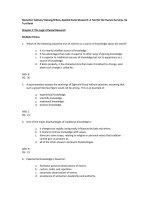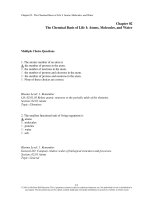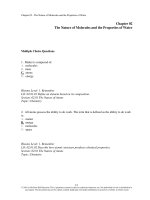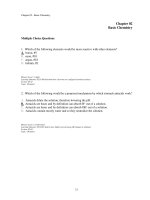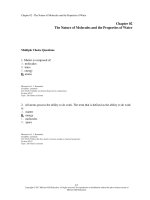Human biology 14th edition mader test bank
Bạn đang xem bản rút gọn của tài liệu. Xem và tải ngay bản đầy đủ của tài liệu tại đây (89.16 KB, 36 trang )
Chapter 02 - Chemistry of Life
Chapter 02
Chemistry of Life
Multiple Choice Questions
1. The smallest unit of an element that still retains the chemical and physical properties of
that element is called
A. an isotope.
B. a nucleus.
C. an atom.
D. a molecular bond.
E. a neutrino.
An atom is the smallest unit of an element that still retains the chemical and physical
properties of that element.
Bloom's Level: 1. Remember
Learning Outcome: 02.01.01 Distinguish between atoms and elements.
Section: 02.01
Topic: Atomic Structure
2. In an atom, the number of protons always equals the number
A. of electrons.
B. of neutrons.
C. of neutrons and protons.
D. of quarks.
E. of neutrinos.
In an atom, the number of protons always equals the number of electrons.
Bloom's Level: 1. Remember
Learning Outcome: 02.01.02 Describe the structure of an atom.
Section: 02.01
Topic: Atomic Structure
2-1
Copyright © 2016 McGraw-Hill Education. All rights reserved. No reproduction or distribution without the prior written consent of
McGraw-Hill Education.
Chapter 02 - Chemistry of Life
3. How many elements occur naturally?
A. 112
B. 92
C. 64
D. 32
E. 6
There are 92 naturally occurring elements.
Bloom's Level: 1. Remember
Learning Outcome: 02.01.01 Distinguish between atoms and elements.
Section: 02.01
Topic: Atomic Structure
4. The atomic number of an atom is determined by the number of
A. protons.
B. neutrons.
C. electrons.
D. protons and neutrons.
E. protons and electrons.
The atomic number of an atom is determined by the number of protons.
Bloom's Level: 1. Remember
Learning Outcome: 02.01.02 Describe the structure of an atom.
Section: 02.01
Topic: Atomic Structure
2-2
Copyright © 2016 McGraw-Hill Education. All rights reserved. No reproduction or distribution without the prior written consent of
McGraw-Hill Education.
Chapter 02 - Chemistry of Life
True / False Questions
5. An element cannot be broken down by chemical means.
TRUE
An element is one of the basic building blocks of matter and cannot be broken down by
chemical means.
Bloom's Level: 1. Remember
Learning Outcome: 02.01.01 Distinguish between atoms and elements.
Section: 02.01
Topic: Atomic Structure
Multiple Choice Questions
6. Why is He positioned above Ne in the periodic table?
A. They both have the same atomic mass.
B. They both have the same number of electrons in their outermost orbital.
C. They both have a full outermost orbital.
D. They both have the same atomic number.
E. They both have the same number of protons in their nuclei.
He has a full outermost orbital with 2 electrons. Ne has a full outermost orbital with 8
electrons.
Bloom's Level: 5. Evaluate
Learning Outcome: 02.01.02 Describe the structure of an atom.
Section: 02.01
Topic: Atomic Structure
2-3
Copyright © 2016 McGraw-Hill Education. All rights reserved. No reproduction or distribution without the prior written consent of
McGraw-Hill Education.
Chapter 02 - Chemistry of Life
7. Be has an atomic number of 4 and an atomic mass of 9. How many protons does it have?
A. 4
B. 5
C. 9
D. 13
E. 7
The atomic number gives the number of protons, so Be has 4 protons.
Bloom's Level: 2. Understand
Learning Outcome: 02.01.02 Describe the structure of an atom.
Section: 02.01
Topic: Atomic Structure
8. What is the symbol for sodium?
A. Na
B. S
C. So
D. N
E. Dm
Na (short for natrium) is the symbol for sodium.
Bloom's Level: 1. Remember
Learning Outcome: 02.01.01 Distinguish between atoms and elements.
Section: 02.01
Topic: Atomic Structure
2-4
Copyright © 2016 McGraw-Hill Education. All rights reserved. No reproduction or distribution without the prior written consent of
McGraw-Hill Education.
Chapter 02 - Chemistry of Life
9. Which of the following elements will have more than 2 electrons and have a full outer
orbital?
A. He
B. Ne
C. C
D. N
E. O
He contains 2 electrons and Ne contains 10 electrons. Both have their outermost orbital filled.
Bloom's Level: 4. Analyze
Learning Outcome: 02.01.02 Describe the structure of an atom.
Section: 02.01
Topic: Atomic Structure
10. Isotopes of an element differ due to the number of
A. protons.
B. neutrons.
C. electrons.
D. both protons and electrons.
E. neutrinos.
Isotopes of an element differ due to the number of neutrons.
Bloom's Level: 2. Understand
Learning Outcome: 02.01.03 Define an isotope and summarize its application in both medicine and biology.
Section: 02.01
Topic: Atomic Structure
2-5
Copyright © 2016 McGraw-Hill Education. All rights reserved. No reproduction or distribution without the prior written consent of
McGraw-Hill Education.
Chapter 02 - Chemistry of Life
11. Carbon dating is a common method employed in dating certain kinds of fossils. It is
based upon the radioactive decay of an isotope of carbon (C14). Referring to the atomic
number of carbon attained from the periodic table, how many neutrons does C14 have?
A. 2
B. 4
C. 8
D. 12
E. 14
Carbon fourteen possesses two more neutrons than carbon twelve, for a total of 8 neutrons.
Bloom's Level: 3. Apply
Learning Outcome: 02.01.03 Define an isotope and summarize its application in both medicine and biology.
Section: 02.01
Topic: Atomic Structure
12. What substance is used in medicine to produce various images of organs and tissues?
A. A mixture
B. A tracer
C. An emulsion
D. A colloid
E. A sensor
Tracers, such as iodine 131, can be used in medicine to produce various images of organs and
tissues.
Bloom's Level: 1. Remember
Learning Outcome: 02.01.03 Define an isotope and summarize its application in both medicine and biology.
Section: 02.01
Topic: Atomic Structure
2-6
Copyright © 2016 McGraw-Hill Education. All rights reserved. No reproduction or distribution without the prior written consent of
McGraw-Hill Education.
Chapter 02 - Chemistry of Life
True / False Questions
13. Radiation can produce both positive and negative effects for humans.
TRUE
Radiation can be used beneficially but can also harm.
Bloom's Level: 2. Understand
Learning Outcome: 02.01.03 Define an isotope and summarize its application in both medicine and biology.
Section: 02.01
Topic: Atomic Structure
Multiple Choice Questions
14. A combination of two or more atoms of the same type is called
A. an atomic unit.
B. a molecule.
C. a compound.
D. an isotope.
E. an ion.
Two or more atoms of the same type that combine are defined as a molecule.
Bloom's Level: 1. Remember
Learning Outcome: 02.01.04 Distinguish between ionic and covalent bonds.
Section: 02.01
Topic: Chemical Bonds
2-7
Copyright © 2016 McGraw-Hill Education. All rights reserved. No reproduction or distribution without the prior written consent of
McGraw-Hill Education.
Chapter 02 - Chemistry of Life
15. Ca3(PO4)2 represents a/an
A. element.
B. mixture.
C. compound.
D. isotope.
E. atom.
Ca3(PO4)2 represents a compound because it is a combination of different atoms.
Bloom's Level: 2. Understand
Learning Outcome: 02.01.04 Distinguish between ionic and covalent bonds.
Section: 02.01
Topic: Chemical Bonds
16. Atoms that share electrons have what type of bonds?
A. covalent
B. neutral
C. hydrogen
D. colloidal
E. ionic
Atoms that share electrons have covalent bonds.
Bloom's Level: 1. Remember
Learning Outcome: 02.01.04 Distinguish between ionic and covalent bonds.
Section: 02.01
Topic: Chemical Bonds
2-8
Copyright © 2016 McGraw-Hill Education. All rights reserved. No reproduction or distribution without the prior written consent of
McGraw-Hill Education.
Chapter 02 - Chemistry of Life
17. CaCl2 is a salt that forms as the result of what type of bond?
A. covalent
B. hydrogen
C. polar
D. non-polar
E. ionic
CaCl2 is a salt that forms as the result of an ionic bond.
Bloom's Level: 3. Apply
Learning Outcome: 02.01.04 Distinguish between ionic and covalent bonds.
Section: 02.01
Topic: Chemical Bonds
True / False Questions
18. Water makes up 60-70% of total body weight.
TRUE
Water is the most abundant molecule in living organisms.
Bloom's Level: 1. Remember
Learning Outcome: 02.02.01 Describe the properties of water.
Section: 02.02
Topic: Properties of Water
2-9
Copyright © 2016 McGraw-Hill Education. All rights reserved. No reproduction or distribution without the prior written consent of
McGraw-Hill Education.
Chapter 02 - Chemistry of Life
Multiple Choice Questions
19. Which type of bond is responsible for holding two water molecules together creating the
properties of water?
A. hydrogen
B. covalent
C. ionic
D. polar
E. double covalent
Hydrogen bonds are the attraction of the hydrogen of one water molecule to the oxygen of a
second water molecule. Due to this type of bond, the properties of water are established.
Bloom's Level: 2. Understand
Learning Outcome: 02.02.02 Explain the role of hydrogen bonds in the properties of water.
Section: 02.02
Topic: Chemical Bonds
20. Hydrogen bonds
A. result from the loss of neutrons by an atom.
B. result in the formation of salts.
C. involve the loss and gain of electrons.
D. involve the sharing of electrons.
E. are relatively weak and can be broken rather easily.
Hydrogen bonds are relatively weak and can be broken rather easily, but are very strong
because there are so many of them.
Bloom's Level: 2. Understand
Learning Outcome: 02.02.02 Explain the role of hydrogen bonds in the properties of water.
Section: 02.02
Topic: Chemical Bonds
2-10
Copyright © 2016 McGraw-Hill Education. All rights reserved. No reproduction or distribution without the prior written consent of
McGraw-Hill Education.
Chapter 02 - Chemistry of Life
21. The reason water is polar is because
A. in polar molecules atoms share electrons evenly.
B. the oxygen atom is larger than the hydrogen atom.
C. hydrophilic molecules interact with water.
D. hydrophobic molecules do not interact with water.
E. there is a transfer of electrons from the hydrogen to the oxygen.
Because the oxygen is larger than the hydrogen, the electron spends more time circling the
oxygen, and therefore, water is polar.
Bloom's Level: 4. Analyze
Learning Outcome: 02.02.02 Explain the role of hydrogen bonds in the properties of water.
Section: 02.02
Topic: Properties of Water
22. Which of the following characteristics of water is most responsible for the sinking of the
Titanic?
A. Water is liquid at room temperature.
B. Water has a high heat of vaporization.
C. The temperature of liquid water rises and falls slowly.
D. Frozen water is less dense than liquid water.
E. Water molecules are cohesive.
Since frozen water is less dense than liquid water, ice, including icebergs, will float in liquid
water.
Bloom's Level: 2. Understand
Learning Outcome: 02.02.01 Describe the properties of water.
Section: 02.02
Topic: Properties of Water
2-11
Copyright © 2016 McGraw-Hill Education. All rights reserved. No reproduction or distribution without the prior written consent of
McGraw-Hill Education.
Chapter 02 - Chemistry of Life
23. On a warm day in April, Tina jumped into the swimming pool. To her surprise the water
was really cold. Which property of water did she discover?
A. Water molecules are cohesive.
B. The temperature of liquid water rises and falls slowly.
C. Water possesses hydrogen bonds.
D. Water is a polar molecule.
E. Frozen water is less dense than liquid water.
Water is a good temperature buffer because a great deal of energy is required to raise the
temperature of water.
Bloom's Level: 4. Analyze
Learning Outcome: 02.02.01 Describe the properties of water.
Section: 02.02
Topic: Properties of Water
24. William noticed water mysteriously climbing up a capillary tube. This is an example of
which property of water?
A. Frozen water is less dense than liquid water.
B. The temperature of liquid water rises and falls slowly.
C. Water molecules are cohesive.
D. Water has a high heat of vaporization.
E. Water is a solvent.
Water climbing up a capillary tube is an example of the cohesive nature of water.
Bloom's Level: 3. Apply
Learning Outcome: 02.02.01 Describe the properties of water.
Section: 02.02
Topic: Properties of Water
2-12
Copyright © 2016 McGraw-Hill Education. All rights reserved. No reproduction or distribution without the prior written consent of
McGraw-Hill Education.
Chapter 02 - Chemistry of Life
25. In an acidic solution
A. the number of H+ is less than the number of OH-.
B. the number of H+ is greater than the number of OH-.
C. the number of H+ is equal to the number of OH-.
D. the number of H+ is 3 times less than the number of OH-.
E. the number of H+ is 10 times less than the number of OH-.
In an acidic solution the number of H+ is greater than the number of OH-.
Bloom's Level: 2. Understand
Learning Outcome: 02.02.03 Summarize the structure of the pH scale and the importance of buffers to biological systems.
Section: 02.02
Topic: Acids and Bases
True / False Questions
26. A solution with a pH of 7 has 10 times as many H+ as a pH of 6.
FALSE
A pH of 7 actually has 10 times fewer H+ as a pH of 6.
Bloom's Level: 2. Understand
Learning Outcome: 02.02.03 Summarize the structure of the pH scale and the importance of buffers to biological systems.
Section: 02.02
Topic: Acids and Bases
2-13
Copyright © 2016 McGraw-Hill Education. All rights reserved. No reproduction or distribution without the prior written consent of
McGraw-Hill Education.
Chapter 02 - Chemistry of Life
Multiple Choice Questions
27. A solution containing 0.00001 moles of H+ has a pH of
A. 3.
B. 5.
C. 7.
D. 9.
E. 11.
This (0.00001 moles) is the same as 1 x 10-5 moles, so the pH would be 5.
Bloom's Level: 4. Analyze
Learning Outcome: 02.02.03 Summarize the structure of the pH scale and the importance of buffers to biological systems.
Section: 02.02
Topic: Acids and Bases
True / False Questions
28. The presence of a buffer in our blood is an example of homeostasis.
TRUE
A buffer maintains the pH within a normal range which is required for homeostasis.
Bloom's Level: 3. Apply
Learning Outcome: 02.02.03 Summarize the structure of the pH scale and the importance of buffers to biological systems.
Section: 02.02
Topic: Acids and Bases
2-14
Copyright © 2016 McGraw-Hill Education. All rights reserved. No reproduction or distribution without the prior written consent of
McGraw-Hill Education.
Chapter 02 - Chemistry of Life
Multiple Choice Questions
29. Joining small molecules (monomers) together to form longer chains (polymers) requires a
process called
A. a hydrolysis reaction.
B. a dehydration reaction.
C. monomerization.
D. emulsification.
E. disassembly.
Polymerization of monomers into polymers requires a process called a dehydration reaction.
Bloom's Level: 1. Remember
Learning Outcome: 02.03.02 Describe the processes by which the organic molecules are assembled and disassembled.
Section: 02.03
Topic: Chemical Reactions
30. Which of the following is not one of the four classes of organic molecules found in cells?
A.
B.
C.
D.
E.
vitamins
lipids
proteins
carbohydrates
nucleic acids
Vitamins are not one of the four categories of organic molecules unique to cells.
Bloom's Level: 2. Understand
Learning Outcome: 02.03.01 List the four classes of organic molecules that are found in cells.
Section: 02.03
Topic: Chemical Reactions
2-15
Copyright © 2016 McGraw-Hill Education. All rights reserved. No reproduction or distribution without the prior written consent of
McGraw-Hill Education.
Chapter 02 - Chemistry of Life
True / False Questions
31. In biology, calling something organic means that it was grown without the use of any type
of herbicide.
FALSE
False. In Biology organic refers to molecules that have carbon and hydrogen in them. This is
usually associated with living organisms.
Bloom's Level: 1. Remember
Learning Outcome: 02.03.01 List the four classes of organic molecules that are found in cells.
Section: 02.03
Topic: Chemical Reactions
32. NaCl is not an organic molecule.
TRUE
Organic molecules contain carbon and hydrogen and NaCl does not.
Bloom's Level: 2. Understand
Learning Outcome: 02.03.01 List the four classes of organic molecules that are found in cells.
Section: 02.03
Topic: Chemical Reactions
33. After lunch our digestive system will use the process of hydrolysis to break the food down
into smaller subunits.
TRUE
True. Hydrolysis is the process of breaking down food into smaller subunits.
Bloom's Level: 1. Remember
Learning Outcome: 02.03.02 Describe the processes by which the organic molecules are assembled and disassembled.
Section: 02.03
Topic: Chemical Reactions
2-16
Copyright © 2016 McGraw-Hill Education. All rights reserved. No reproduction or distribution without the prior written consent of
McGraw-Hill Education.
Chapter 02 - Chemistry of Life
34. A hydrolysis reaction involves the loss of water.
FALSE
A hydrolysis reaction involves the addition of water.
Bloom's Level: 2. Understand
Learning Outcome: 02.03.02 Describe the processes by which the organic molecules are assembled and disassembled.
Section: 02.03
Topic: Chemical Reactions
Multiple Choice Questions
35. Which grouping of elements is found in carbohydrates?
A. C - H - O
B. C - H - P
C. H - O - Cl
D. N - S - O
E. Ca - H - O
Carbon (C), Hydrogen (H), and Oxygen (O) are the primary elements that make up the basic
structure of carbohydrates.
Bloom's Level: 1. Remember
Learning Outcome: 02.04.01 Summarize the basic chemical properties of a carbohydrate.
Section: 02.04
Topic: Carbohydrates
2-17
Copyright © 2016 McGraw-Hill Education. All rights reserved. No reproduction or distribution without the prior written consent of
McGraw-Hill Education.
Chapter 02 - Chemistry of Life
36. Sugars with three to seven carbon atoms are called
A. monosaccharides.
B. disaccharides.
C. trisaccharides.
D. polysaccharides.
E. steroids.
Sugars with only three to seven carbon atoms are called simple sugars or monosaccharides.
Bloom's Level: 1. Remember
Learning Outcome: 02.04.01 Summarize the basic chemical properties of a carbohydrate.
Section: 02.04
Topic: Carbohydrates
37. If a person is looking to eat a breakfast that will help supply them with energy for the
entire course of the day, which of the following foods would they want to include?
A. pancakes with maple syrup
B. bacon, eggs, and toast
C. cup of coffee and a donut
D. bowl of grapes and a glass of milk
E. All of these choices would provide the same potential for all day energy.
Pancakes with maple syrup would provide the person with the best form of complex
carbohydrates (polysaccharides). These would be broken down slowly over the course of the
day providing a long term source of energy. Bacon, eggs, and toast would have a limited
amount of carbohydrates available for energy. This meal would primarily provide protein and
fats to the person. A cup of coffee and a donut would provide almost no polysaccharides. The
donut is primarily composed of glucose. A bowl of grapes and a glass of milk would provide
the person with a large amount of disaccharides.
Bloom's Level: 5. Evaluate
Learning Outcome: 02.04.02 State the roles of carbohydrates in human physiology.
Section: 02.04
Topic: Carbohydrates
2-18
Copyright © 2016 McGraw-Hill Education. All rights reserved. No reproduction or distribution without the prior written consent of
McGraw-Hill Education.
Chapter 02 - Chemistry of Life
38. Which of the following is not a monosaccharide?
A. glucose
B. fructose
C. galactose
D. maltose
E. None of these are monosaccharides.
All of these are single sugars except maltose which is a disaccharide composed of two
glucose molecules.
Bloom's Level: 1. Remember
Learning Outcome: 02.04.01 Summarize the basic chemical properties of a carbohydrate.
Section: 02.04
Topic: Carbohydrates
39. Which polysacccharide is stored as an energy source in the body of animals?
A. glycogen
B. glucose
C. cellulose
D. starch
E. chitin
Glycogen is a polysaccharide that is stored in the muscle tissue and blood of animals.
Glucose is a monosaccharide that can be found in both plant and animals. Cellulose and
starch are both polysaccharides that are found in members of Kingdom Plantae. Chitin is a
polysaccharide found in the fungi and the exoskeleton of insects and crustaceans. It is not
stored as an energy source.
Bloom's Level: 2. Understand
Learning Outcome: 02.04.03 Compare the structure of simple and complex carbohydrates.
Section: 02.04
Topic: Carbohydrates
2-19
Copyright © 2016 McGraw-Hill Education. All rights reserved. No reproduction or distribution without the prior written consent of
McGraw-Hill Education.
Chapter 02 - Chemistry of Life
40. What passes through the digestive tract as fiber or roughage?
A. Maltose
B. Glucose
C. Glycogen
D. Starch
E. Cellulose
Cellulose passes through the digestive tract as fiber or roughage because we are unable to
break it down.
Bloom's Level: 1. Remember
Learning Outcome: 02.04.04 Explain the importance of fiber in the diet.
Section: 02.04
Topic: Carbohydrates
41. Which of the following foods would be a good source of fiber?
A. All of these are good sources of fiber.
B. peaches
C. whole wheat bread
D. peanuts
E. bran cereal
All of these are a good source of fiber. Fruits are a type of soluble fiber. Bran, nuts, seeds,
and whole wheat foods are forms of insoluble fiber.
Bloom's Level: 2. Understand
Learning Outcome: 02.04.04 Explain the importance of fiber in the diet.
Section: 02.04
Topic: Carbohydrates
2-20
Copyright © 2016 McGraw-Hill Education. All rights reserved. No reproduction or distribution without the prior written consent of
McGraw-Hill Education.
Chapter 02 - Chemistry of Life
42. Which polysaccharide is branched the most?
A. cellulose
B. starch
C. glycogen
D. glucose
E. fructose
Glycogen has more side chains than the others. Glucose and fructose are monosaccharides
with relatively few side branches.
Bloom's Level: 4. Analyze
Learning Outcome: 02.04.03 Compare the structure of simple and complex carbohydrates.
Section: 02.04
Topic: Carbohydrates
43. Which polysaccharide is consumed as a source of fiber?
A. cellulose
B. glycogen
C. glucose
D. chitin
E. starch
Cellulose is the main polysaccharide that functions as a source of fiber in our diets.
Glycogen is a polysaccharide but it acts as a backup source of energy for our body. Glucose
is a monosaccharide that acts as a quick source of energy for our body. Chitin is a
polysaccharide but it is not a source of fiber for our body. Starch is a polysaccharide but it is
digested into glucose and used as a source of energy.
Bloom's Level: 3. Apply
Learning Outcome: 02.04.04 Explain the importance of fiber in the diet.
Section: 02.04
Topic: Carbohydrates
2-21
Copyright © 2016 McGraw-Hill Education. All rights reserved. No reproduction or distribution without the prior written consent of
McGraw-Hill Education.
Chapter 02 - Chemistry of Life
True / False Questions
44. The main function of carbohydrates is for long-term energy storage.
FALSE
The main function of carbohydrates is for quick and short-term energy storage.
Bloom's Level: 2. Understand
Learning Outcome: 02.04.02 State the roles of carbohydrates in human physiology.
Section: 02.04
Topic: Carbohydrates
45. Our body is capable of converting starch into glycogen.
TRUE
We eat starchy foods, and the glucose enters the bloodstream. The liver then can store this
glucose as glycogen.
Bloom's Level: 3. Apply
Learning Outcome: 02.04.02 State the roles of carbohydrates in human physiology.
Section: 02.04
Topic: Carbohydrates
2-22
Copyright © 2016 McGraw-Hill Education. All rights reserved. No reproduction or distribution without the prior written consent of
McGraw-Hill Education.
Chapter 02 - Chemistry of Life
Multiple Choice Questions
46. Starch, cellulose, and glycogen are alike in that
A. they are all made of glucose.
B. they contain the same number of side chains.
C. they have the same types of bonds between the monomer units.
D. they are all found in animals.
E. they can all be digested by our bodies.
Starch, glycogen, and cellulose are all made of glucose molecules.
Bloom's Level: 2. Understand
Learning Outcome: 02.04.03 Compare the structure of simple and complex carbohydrates.
Section: 02.04
Topic: Carbohydrates
47. A fat contains how many fatty acids?
A. 1
B. 2
C. 3
D. 4
E. 5
A fat, or triglyceride, contains three fatty acids.
Bloom's Level: 2. Understand
Learning Outcome: 02.05.01 Compare the structure of fats, phospholipids, and steroids.
Section: 02.05
Topic: Lipids
2-23
Copyright © 2016 McGraw-Hill Education. All rights reserved. No reproduction or distribution without the prior written consent of
McGraw-Hill Education.
Chapter 02 - Chemistry of Life
48. How are fats, phospholipids, and steroids alike?
A. They are all solid at room temperature.
B. They each contain a polar phosphate group.
C. They each contain only 1 fatty acid.
D. They do not dissolve in water.
E. They all contain at least one carbon ring.
All lipids are insoluble in water.
Bloom's Level: 4. Analyze
Learning Outcome: 02.05.01 Compare the structure of fats, phospholipids, and steroids.
Section: 02.05
Topic: Lipids
49. A fatty acid that contains only single bonds between the carbon atoms is considered
A. saturated.
B. unsaturated.
C. trans unsaturated.
D. a cholestrol.
E. a steroid.
If all the carbon atoms are connected by single bonds, the fatty acid is considered saturated.
Bloom's Level: 2. Understand
Learning Outcome: 02.05.01 Compare the structure of fats, phospholipids, and steroids.
Section: 02.05
Topic: Lipids
2-24
Copyright © 2016 McGraw-Hill Education. All rights reserved. No reproduction or distribution without the prior written consent of
McGraw-Hill Education.
Chapter 02 - Chemistry of Life
True / False Questions
50. Fats are usually of animal origin while oils are usually of plant origin.
TRUE
Fats, such as lard and butter, are of animal origin, while oils, such as corn oil and soybean oil,
are of plant origin.
Bloom's Level: 1. Remember
Learning Outcome: 02.05.01 Compare the structure of fats, phospholipids, and steroids.
Section: 02.05
Topic: Lipids
Multiple Choice Questions
51. The sex hormones belong to which category of lipids?
A. steroids
B. fats
C. oils
D. triglycerides
E. phospholipids
The sex hormones are steroids.
Bloom's Level: 2. Understand
Learning Outcome: 02.05.02 State the function of each class of lipids.
Section: 02.05
Topic: Lipids
2-25
Copyright © 2016 McGraw-Hill Education. All rights reserved. No reproduction or distribution without the prior written consent of
McGraw-Hill Education.


